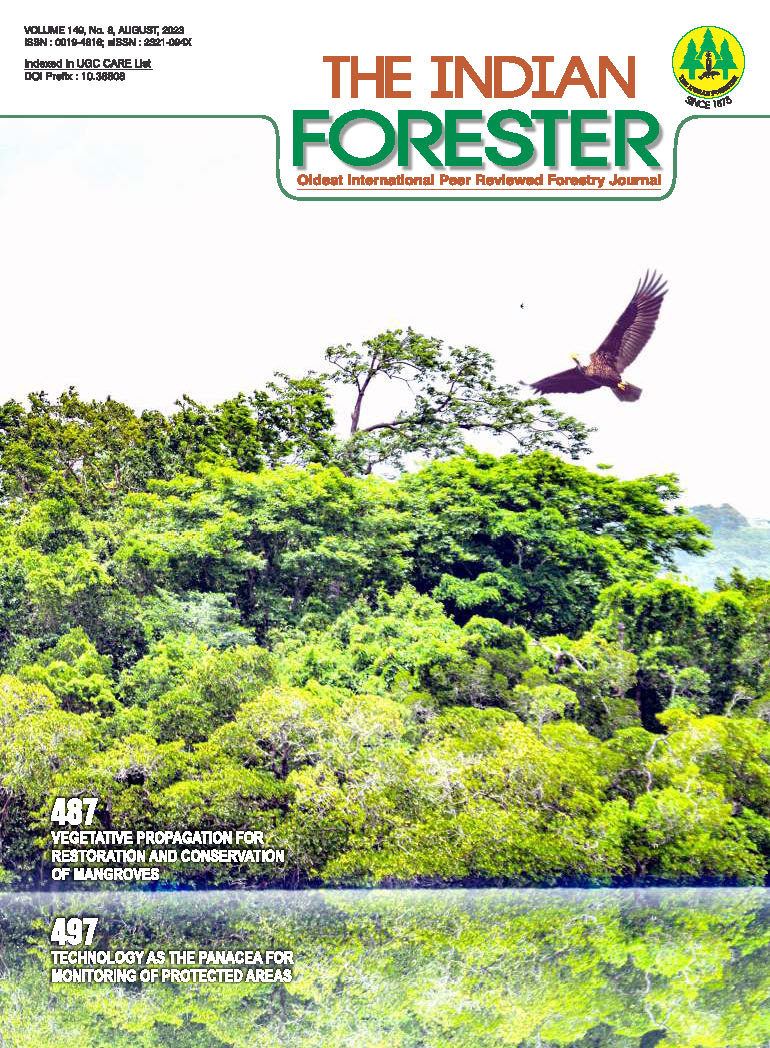Corticolous Lichen Species Association on Shrubs in Temperate Forests of Kumaun Himalaya
DOI:
https://doi.org/10.36808/if/2023/v149i8/169548Keywords:
Lichen Species Association, Shrubs, Temperate Forests, Kumaun Himalaya.Abstract
During the study the maximum 18 corticolous lichen species belonging to 12 genera and five families were recorded from the study area. The best association of lichen species with all growth forms was observed on the shrub Cotoneaster microphyllus Wall. ex Lindl. at high altitude zone. It is situated above 1800m altitude at Moru oak forest (Quercus floribunda Lindl. ex A. Camus) and represented by nine species of lichens. The shrub Berberis petiolaris Wall. ex G. Don is also expressed an instance of shrub species at high altitude region which support to the occurrence of maximum five species of lichens with a good combination of foliose and fruticose forms. The present study is an exploration of the contribution of shrub species which provide a suitable habitat to flourish the lichen species in the area.References
Ahmadjian V. (1995). Lichens are more important than you think. Bioscience, 45(3): 124.
Arya V., Kumar B. and Arya P. (2019). Lichen Wealth of Uttarakhand Himalaya. Lambert Academic Publishing, Mauritius, 1-99.
Awasthi D.D. (1988). A key to the macrolichens of India and Nepal. The Journal of the Hattori Botanical Laboratory, 65: 207-302.
Awasthi D.D. (1991). A key to the microlichens of India, Napal and Sri Lanka. Biblioth. Lichenol, 40: 1- 337.
Awasthi D.D. (2000). A hand book of lichens. Bishen Singh Mahendra Pal Singh, Dehradun, India.
Awasthi D.D. (2007). A compendium of the macrolichens from India, Nepal and Sri Lanka. Bishen Singh and Mahendera Pal Singh, Dehradun, India.
Babington C. (1852). Lichenes Himalayenses: being an Enumeration of the Lichens collected in the Himalaya Mountains etc. during the years 1847 and 1848. Hooker's J Bot Kew Gard Misc, 4: 243-253.
Bisht K., Joshi Y., Tripathi M. and Upreti D.K. (2013). Estimation of epiphytic macrolichen biomass in Binsar Wildlife Sanctuary (BWS), Almora, Uttarakhand, India. Journal of Environmental Science and Technology, 1(3): 62-70.
Divakar P.K. and Upreti D.K. (2005). Parmelioid Lichens in India (a revisionary study). Bishen and Mahendera Pal Singh, Dehradun, India.
Joshi Y. (2014). Distribution and Diversity of Lichenized Fungi Colonizing Jageshwar Group of Temples, Almora, Uttarakhand. Proc. Natl. Acad. Sci., India, Sect. B Biol. Sci., 85(2): 545-554.
Kosanic M., Ranković B. and Stanojković T. (2013). Investigation of selected Serbian lichens for antioxidant, antimicrobial and anticancer properties. J. Anim. Plant Sci., 23: 1628-1633.
Nayaka S. (2004): Revisionary studies on lichen genus Lecanora sensu lato in India. Ph.D. thesis. Submitted to Dr. Ram Manohar Lohia Avadh University.
Rajan V.P., Gunasekaran S., Ramanathan S., Murugaiyah V., Samsudin M.W. and Din L.B. (2016). Biological activities of four Parmotrema species of Malaysian origin and their chemical constituents. Journal of Applied Pharmaceutical Science, 6(8): 36-43.
Singh K.P. and Sinha G.P. (2010). Indian Lichens: an annotated checklist. Botanical Survey of India, Kolkata.
Sonam Kumar B., Arya V. and Upreti D.K. (2017). Lichens as key indicator of forest health in Sauni-Binsar grove, Kumaun Himalaya, India. Indian Journal of Ecology, 44(3): 654-657.
Downloads
Downloads
Published
How to Cite
Issue
Section
License
Unless otherwise stated, copyright or similar rights in all materials presented on the site, including graphical images, are owned by Indian Forester.





